MONKEY Manual
MONKEY is an ultra-portable and versatile 2-octave Bluetooth MIDI keyboard.
For further support, please email us or join our discord server.
Hardware overview
MONKEY features a 2-octave keybed starting on the F-key. Play it as a typical MIDI keyboard, or access its extended capabilities through the SHIFT key.
MONKEY gives feedback to the user through its LEDs. The light tower LED will give general feedback from function manipulations. The monkey LEDs will give feedback related to the loop recorder functionality.
The white circular moon in the middle of the device is a touch surface. When pressed, it will send MIDI CC Modulation according to the pressure applied.
The lock switch is used to disable the keyboard. Note that it does not turn off the unit, but forces it into a low-power state and the keybed is disabled. Generally, you do not need to bother with the lock-switch, but it is there for the cases where it might be practical to disable the device, such as traveling. You do not need to turn off MONKEY. It will make sure to use as little battery as possible by it’s own.
Communication is only through Bluetooth.
Getting started
To get started, we refer to the Getting Started guide. We recommend having MONKEY powered up and connected to a host while going through the rest of the manual.
Functions
The functions are organized into groups. The functions highlighted with a white circle are the MIDI effects, going from ARP to DRM. The functions to the left of these effects are general settings, and to the right, we have the loop recorder + WAKE.
MONKEY has a system wide note polyphony of 20 notes.
The SHIFT key
Use the SHIFT key to access all the functions. While holding down SHIFT you gain access to all the functions printed below the bottom keys. As soon as you release the SHIFT key, MONKEY will exit function mode and you are back to playing the keys as normal. Thus while you are applying functions, keep the SHIFT key pressed for the entire duration. Releasing the SHIFT key will cancel the current operation.
Each of the functions have a simple interface. There are two types of functions:
- Function is directly applied by pressing the key
- Function is applied after pressing the key followed by a sequence of numbers using the numbered keys
Furthermore each function might also have a long press function. When prompted to type in numbers for a long press function, the light tower will blink but with a different blink pattern than with a normal press blink pattern. This way you can distinguish wether you are about to do a normal press action or a long press action. The long press action is activated if you keep a function key pressed for more than 1 second.
Below you can see a table of how each of the functions behave, according to the two function types listed above.
THe light tower will directly indicate what you should do or what happened. For the function which toggle (HOLD and the effects) the light tower will blink once when activating and blink twise when deactivating.
WAKE
The first function you should get familiar with is the WAKE key. Pressing SHIFT + WAKE will reset the device, and SHIFT + long pressing WAKE will reboot the device. If you ever get lost, use WAKE to quickly reset the device state back to it’s default state.
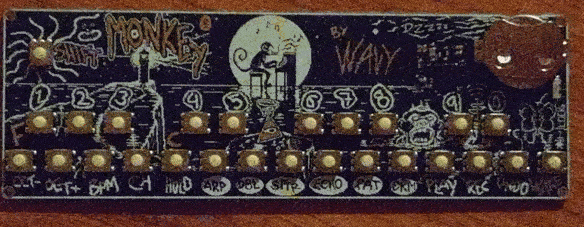
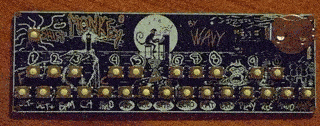
OCT- and OCT+
OCT- and OCT+ are the most straightforward functions as they only change the octave range of the keybed. OCT- decrements the current octave while OCT+ increments the current octave. The light tower will blink once when you change the octave. When you hit the octave limits it will blink 4 times indicating it is unable to increment or decrement any further.
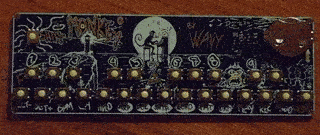
BPM
BPM stands for beats per minute and let’s you change the global tempo of MONKEY. WHile pressing SHIFT, press BPM followed by typing your desired BPM using the numbered keys.
By defauly the BPM on MONKEY is 120.
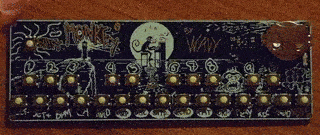
CH
To use MONKEY with multiple instruments at the same time, you can configure each instrument to receive notes on different channels. Then you can use the CH function on MONKEY to change betweeen these instruments.
While pressing SHIFT, press CH followed by your desired channel. Selecting 0 corresponds to MIDI channel 10.
CAUTION: Make sure to distinguish between a short press and long press on CH key. Long pressing CH allows you to mute/unmute specific MIDI channels. Use the numbered keys to select the channels which you would like to mute/unmute. This is useful paired together with the loop recorder, muting parts of your loop.
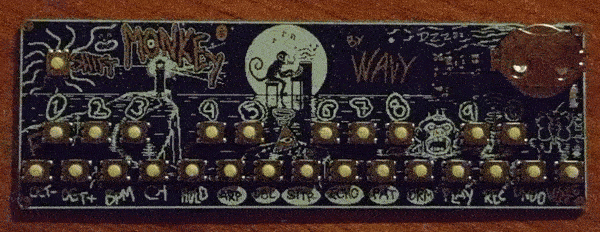
HOLD
Toggle note hold using the HOLD function. Notice the light tower LED blinking once if the function was enabled and twice if it was disabled.
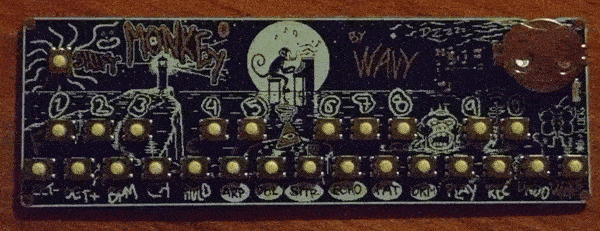
MIDI effects
MONKEY has in total 6 MIDI effects each with 10 presets. Similarly to HOLD, the effects are toggled on and off. Only one effect might be enabled at once.
- If you enable a new effect and a previous effect was enabled, this new effect will be enabled and the previous disabled.
- If you press on the effect which is already enabled, it will disable and no effects will be enabled.
Once an effect is enabled, you can change its preset. This is simply done by directly pressing the numbered keys while in SHIFT mode.
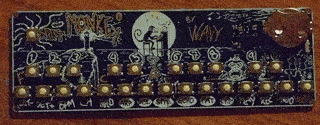
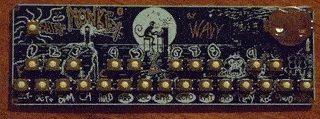
ARP
Arpeggio effect. Presets change the arpeggio algorithm.
DBL
Double effect. For each key you press, this effect will add extra notes. The presets change which notes are added and with what delay.
STTR
Stutter effect. Plays the notes which are pressed in a rythmic pattern. The presets change the pattern.
ECHO
The echo effect will repeat the notes you play in a feedback loop. The behaviour of each preset are varied and unconventional by design. Some presets have a infinite feedback loop where the note is not removed from the loop until the velocity of the key reaches 0.
PAT
Pattern effect. Pre-made note patterns. Preset changes the swing.
DRM
Drum effect. The bottom keys are drum loops and the upper keys are drum fills. You can dynamically switch between loops and the effect will keep correct timing, as long as at least one loop key is being pressed. The preset changes the swing.
Loop recorder
The loop recorder is your playground to combine recordings from multiple instruments into an idea. Currently, the loop recorder is fixed with a length of 16 beats. The loop recorder uses the following keys:
- PLAY: Toggle on and off loop playback. The monkey LEDs will blink in tempo during playback.
- REC: Toggle on and off loop recording. The behavior of this key depends on if the loop is currently playing or not. If it is not playing, it will toggle on and off “arm to record.” The monkey LEDs will then be solid. As soon as you start playing on the keys, the looper will start playing and recording. If the looper is already playing, then recording will be toggled on and off. Notice how the monkey LEDs blink differently between only playback and playback with recording. When recording, the LEDs will remain lit longer.
- UNDO: Each time you stop recording, a new record checkpoint is generated. Pressing UNDO will erase the last checkpoint. Long pressing UNDO will allow you to select an entire MIDI channel to erase. After SHIFT + long press UNDO, while keeping SHIFT pressed, select the MIDI channel to erase by pressing a corresponding numbered key. As always, the number 0 is MIDI channel 10 and is reserved for the drums.
Recommendations
It’s a good idea to record something rhythmical initially so that you keep track of the tempo and know when the loop recorder loops back on itself. If you don’t want to have rhythmical elements in your loop, you might first record something rhythmical such as drums. Then, when you have recorded something on top of the drums, erase the drums from the loop (UNDO long press).
It is also possible to create a simple arrangement using the channel mute functionality (CH long press). Record various elements on different MIDI channels. Then you can arrange your idea by changing which channels are muted and not.
When recording something periodic such as drums, you do not need to time releasing the key just as the looper loops back on itself. When exactly the same notes are repeated on top of each other, the looper will notice and not record the notes on top of each other.